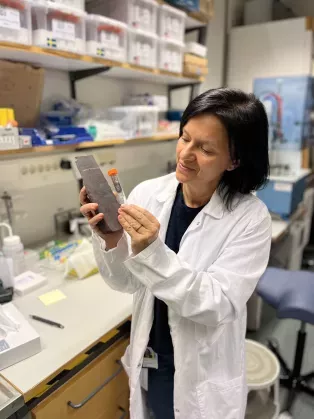IVA's list highlights current research that can benefit society. The purpose is, among other things, to raise the ideas so that they can arouse interest in - and gain traction from - more collaborative actors. Emma Hammarlund sees precisely that part as important for the project. Although the connection to medical research was not immediately clear to the medical research colleagues, it was Emma Hammarlund's background as a geologist that gave birth to the idea: the progress of a cancer can be tracked via hair analysis. Nowadays, Emma Hammarlund is also an associate professor in medicine at Lund University, with a focus on developmental biology.
Cancer cells' higher metabolism means that various elements are metabolized faster than in other cells. According to Emma Hammarlund's hypothesis, this will appear as chemical imprints in the hairs. When the elemental composition of stable isotopes is examined in the hairs, traces of "voracious" cancer cells are revealed. A number of elements in the hair will be investigated within the project. Several elements have different types of themselves, so-called isotopes. The chemical composition is almost identical, but between different isotopes the number of neutrons in the atomic nucleus differs slightly.
The research aims to see how hungry cancer cells use even harder-to-reach isotopes, in contrast to how calmer cells behave. This mechanism is studied by mapping chemical changes directly in the tissue of mice, but also directly in hair analyses. To help them, the research team also uses AI algorithms.
Having already tested the idea both on tissue from mice and hair from humans, Emma Hammarlund still strongly believes in her hypothesis.
"It is too early to change gears, but the prototype looks good," says Emma Hammarlund.
The idea is to be able to design a reliable hair analysis for a variety of cancers. Emma Hammarlund's long-term hope is that the analysis will be able to support other methods of finding cancer early - and in time for it to be cured.
"A cancer that is detected early reduces mortality and suffering - and saves society a lot of money."
So far, hair from men both with and without localized prostate cancer (cancer that has not spread) has been collected, thanks to the involvement of oncology professor Ken Pienta at Johns Hopkins in the US in the project. Other researchers in the project are Lund University colleague and bioinformatician Kazi Uddin, and chemist Per Malmberg at Chalmers. Emma Hammarlund would also like to mention two other important players: Anders Bjartell and Emma Niméus, who both do research at Lund University and work clinically at Skåne University Hospital. It is their team that is currently helping to collect hair from Swedish patients with prostate and breast cancer. Hair from healthy women and men, for the control group, has been collected from hairdressers in Skåne and Stockholm.
"The performance of the first hair test will later be tested in a clinical study. We will start doing that as soon as the next algorithm is fully developed," says Emma Hammarlund.
Funders for the study are the Cancerfonden and the Sjöberg Foundation.







